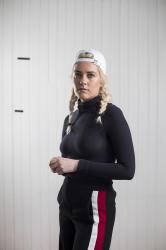
As a flicker of light appears at the end of the pandemic tunnel, we sat down with the next generation of Icelandic artists to discuss the future. The conversations were freeform—some focused on the upcoming years, others reflected on realisations from the past months, others still looked with wide-eyes at the future of the scene, which has only grown within the restrictions of the coronavirus.
Presenting, an artistic vision of the future, as told by the future. Today, we talk to Una Björg Magnúsdóttir.

Una Björg Magnúsdóttir. Photo by Art Bicnick
Una Björg Magnúsdóttir
“I just think that time slowed down for me, which was kind of positive,” Una Björg Magnúsdóttir says of her 2020 experience. “But in general, time just slowed down. There were so many periods of last year so it’s weird to look back at March and what we thought then.” She pauses, shrugging. “But we judge based on what we know now.”

Artwork by Una Björg Magnúsdóttir.
Unconscious reactions
Una’s works are potentially the most reliant on in-person interactions of everyone featured. Looking at pieces like her last exhibition at Hafnarhús in early 2020 entitled ‘Vanishing Crowd’, and it’s hard to imagine how she could, or did, transfer such all-encompassing sensual experiences into pandemic-friendly digital platforms—though she did manage to find ways.
“I do sculptures and installations that kind of play with your assumptions, anticipation and disappointment,” she explains. “Oftentimes, I like to present something that is quite familiar to viewers so that you almost decide immediately that you know what you’re looking at. So there’s a physical reaction—your body reacts before you’re conscious of it.”
“Like with ‘Vanishing Crowd’, when people enter, the installation is so simple that you’re not even sure it’s an exhibition, but then there are small hints that show you that everything is put there intentionally,” she continues carefully. “So even though you’ve decided when you go in there that it’s really simple—just a lobby or a waiting room—it’s completely constructed. It’s fake. Basically, you see both sides, like a magic trick.”

Artwork by Una Björg Magnúsdóttir.
New specialisations
With art that’s so heavily reliant on subjective, small experiences, it’s natural to see how Una adopted a role as an observer in the pandemic. While she was, of course, interested in how the art world reformatted itself to fit new platforms, she was, perhaps, more engrossed by the ways the world as a whole did.
“I was quite fascinated all year with things like the people who are, say, recording funerals or something like that,” she explains. “I feel like things like that are the things that are going to last or keep on going.” She pauses, acknowledging both the ludicrousness and morbidity of the example.
“You know, you take the clichés of how you record something, like how you record opera that is streamed online. It’s not recorded like concerts, it’s recorded in a special way by professionals that specialise in recording operas,” she continues. “Will there now be a specialised way of recording funerals? Of course, it’s awkward if it’s badly filmed.”
She lets out a stark laugh—and you can’t help imagine that yes, it’d be incredibly awkward to watch a funeral filmed by someone who specialises in, say, celebratory wedding videos.
But when asked about the post-pandemic art world, Una is most excited to get back to the fully-fledged in-person museum experience. “It’s like going abroad and then coming home. And even though everything is exactly the same—you expect it to be different—but it’s the same,” she concludes, smiling. “Everything is just a little bit newer.”

Artwork by Una Björg Magnúsdóttir.
Check out Una Björg Magnúsdóttir at her website.
Note: Due to the effect the Coronavirus is having on tourism in Iceland, it’s become increasingly difficult for the Grapevine to survive. If you enjoy our content and want to help the Grapevine’s journalists do things like eat and pay rent, please consider joining our High Five Club.
You can also check out our shop, loaded with books, apparel and other cool merch, that you can buy and have delivered right to your door.
Buy subscriptions, t-shirts and more from our shop right here!














